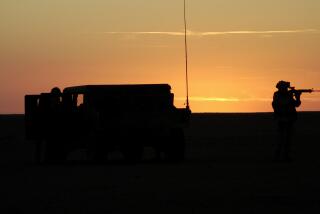Revisiting the Killing Islands of the Pacific : NONFICTION : TOUCHED WITH FIRE: The Land War in the South Pacific.<i> By Eric Bergerud (Viking: $34.95, 576 pp.)</i> : MY FATHERâS WAR: A Sonâs Journey.<i> By Peter Richmond (Simon & Schuster: $23, 263 pp.)</i>
One of their number is running for president, but the generation of men formed in the crucible of World War II is fading. Even if they survived a killing ground like Peleliu in the South Pacific, underage recruits who lied their way into the Marines are in their mid- or late-60s now--and every reunion draws from a steadily diminishing pool. Yet time, they claim, has not dimmed their memories. What happens on a battlefield is indelible.
Both these books draw heavily from veteransâ private memories to paint a harrowing picture of the Pacific war. While the United States and Japan were not old enemies, the Pacific theater of operations was arguably the cruelest in the global conflict. True, on the Eastern Front the Germans starved, worked to death and sometimes executed Russian POWs--Slavs being considered sub-human, along with Gypsies and Jews. But for sheer savagery at the tip of the spear, the Pacific war was unparalleled.
It was a function of the racial overtones in this theater, along with the Japanese martial code, that viewed death as superior to surrender. Then, too, a hostile tropical climate in no small way underwrote the reversion back to the most atavistic behavior imaginable.
As one participant recounts in a passage from âTouched with Fireâ:
âJungle smells in a combat situation are almost impossible to describe. . . . The stench [of decaying bodies] is unbelievable. . . . When a man is killed the flies attack him by the millions right away. The maggots are there three or four hours later. Itâs a horrible sight: the maggots are in and out of the mouth, nose, ears, eyes. On day four or five the swollen body, full of maggots and oily-like, bursts and Jesus, what a horrible stench. If you try to pick up the body by taking an arm or leg, you end up with an arm or leg in your hand.â
Apart from using such graphic recollections to communicate what Oliver Wendell Holmes called the âincommunicable experience of war,â these two books are starkly different in concept and execution. âTouched with Fireâ is written by a professor at Lincoln University and accomplished military historian, and it clearly aspires to do for the ground war in the South Pacific what John Keegan achieved in his masterful âSix Armies in Normandy.â
By contrast, Peter Richmondâs book is taut, eloquent and frequently biting in its observations. While the core is the story of the sonâs quest to learn about his fatherâs wartime service in the Marines, the book is much more than that. It is a meditation on fathers and sons and the formative experience of a previous generation: What makes men fight, and the dilemma of officers who hold the power of life over other men--sometimes ordering them to die.
In his book, Bergerud is intent on righting what he perceives as several historical wrongs. He makes a persuasive argument that the 18-month ground war between Allied and Japanese forces in the South Pacific has been unfairly forgotten, eclipsed in the public mind by the earlier dramatic encounters at Pearl Harbor, Bataan and Midway and the later, bloody clashes at Saipan, Iwo Jima and Okinawa. Drawing heavily from the official histories commissioned by the U.S. and Australian armed forces, the author contends that the Marine and (mostly) Army campaigns in New Guinea, New Britain and the Solomon Islands most accurately illustrate the âturning of the tideâ in the Pacific.
Unlike the period from mid-1944 onward, when American materiel strength overwhelmed Japan and allowed the Allies to more or less dictate events, the period from mid-1942 to early 1944 saw the two sides competing on roughly equal terms. Consequently, Bergerud believes, it is the best terrain for fairly judging the combatantsâ respective strategies and tactics in a âferocious slugging match between light-infantry armies at extremely close quarters.â
This perspective will rankle Navy and Marine veterans. While not discounting their bravery or accomplishments at Midway or Guadalcanal, his emphasis on restoring U.S. Army achievements to the front rank of the Pacific war comes at their expense. This is a bitter 50-year-old argument to which Professor Bergerud adds little but more fuel to the Armyâs side.
Gen. Douglas MacArthurâs forces deftly âcut through Japanese force with easeâ via maneuver and firepower, he writes, but Adm. Ernest King pursued a âblind and foolish strategyâ in the Navyâs Central Pacific thrust toward the Japanese home islands. Fifty years would seem sufficient time to acknowledge that, at times, each of the armed services committed prideful errors of judgment that led to needless casualties. But if the standard is needless death and destruction, what about the civilian casualties incurred to redeem MacArthurâs pledge that he would retake the Philippines? Bergerudâs well-taken point about the significance of the ground campaign in the South Pacific is diminished, not enhanced, by such bias.
Whereas âTouched With Fireâ is encyclopedic war history, even a bit repetitive and didactic at times, Peter Richmondâs book is intensely personal. By skillfully weaving an account of his fatherâs footsteps through Guadalcanal, New Britain and Peleliu and his own efforts to retrace literally those footsteps years later, Richmond, a special correspondent for GQ, comes to grips with a legacy he never had the privilege of knowing first-hand as an adult.
In December 1960, as he was returning home from a business trip, former Marine Lt. Col. Tom Richmond died when the passenger jet carrying him collided with another airplane over Staten Island. Richmondâs DC-8 stayed in the air for eight minutes before landing on a Brooklyn church.
War mementos and booty--including a blood-stained Japanese flag--kept the memory of Tom Richmondâs service alive in his household long after he died. But when Peter Richmond began his quest through the past, he worried that he might discover something that would tarnish his fatherâs image. To the sonâs obvious pride, Tom Richmond turned out to be the bona fide item, a Marine officer who commanded loyalty and deep respect, brave but not fool-hardy. Tom Richmond would never have talked about himself or his deeds in this manner, so it turns out that the only way his son could have gained this understanding was by returning to his fatherâs battlegrounds.
The only flaw in this otherwise poignant memoir occurs when Richmond, 43, infrequently ventures an observation or two about war. Then he reveals that, although he comprehends his fatherâs experiences, this insight has not led him to reflect on his own times. The main virtue of studying lessons learned by an earlier generation is the perspective one gains, and subsequent ability to look anew at oneâs own formative experience. But Richmond still labors under the conceits and cynicism of his own age group. This leads him to make some questionable accusations, such as his assertion that until Vietnam âthe military was not yet perceived as something to be used largely for political purposes.â
Presidents never meddled in wartime strategy until Lyndon B. Johnson? Tell that to Abraham Lincoln, much less to Franklin D. Roosevelt.
More to Read
Sign up for our Book Club newsletter
Get the latest news, events and more from the Los Angeles Times Book Club, and help us get L.A. reading and talking.
You may occasionally receive promotional content from the Los Angeles Times.






